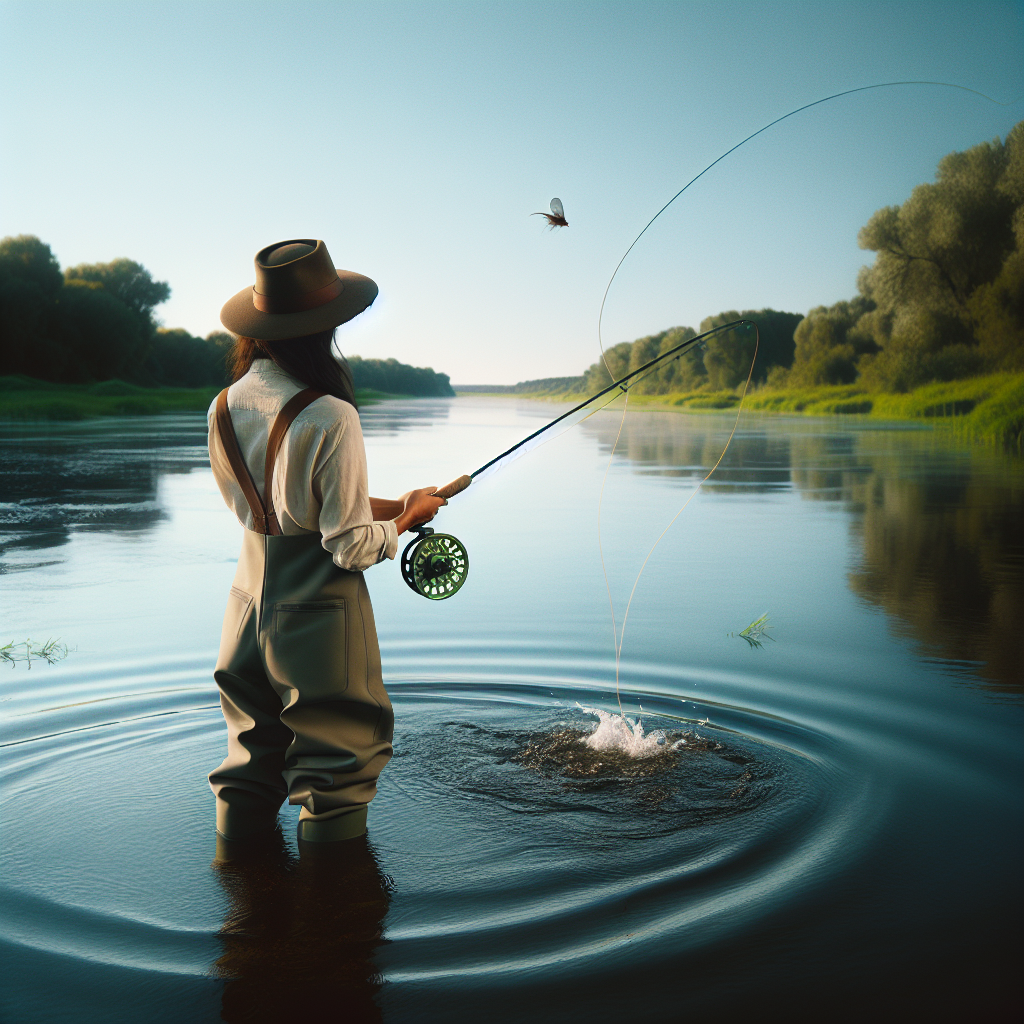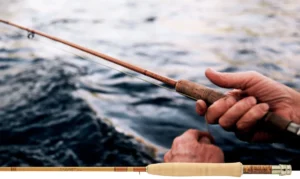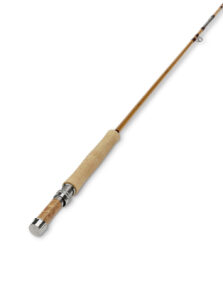Article-At-A-Glance
-
Bamboo rods offer a unique, smooth casting experience unlike modern materials.
-
R.L. Winston has been perfecting bamboo rod craftsmanship since 1929.
-
Choosing the correct bamboo rod involves understanding your fly fishing style and local conditions.
-
Proper rod setup is crucial for optimizing performance and preserving the rod’s integrity.
-
Maintaining a bamboo rod involves regular cleaning, careful storage, and timely repairs.
The Essence of Bamboo: Why Winston Rods Are Unique
Bamboo fly rods are revered for their classic feel and the artful experience they bring to fly fishing. The material itself—a natural grass—possesses a flexibility and resilience that synthetic materials can’t quite replicate. When you hold a bamboo rod, you’re not just holding a tool; you’re holding a piece of angling history, one that connects you to the very roots of the sport.
Now, R.L. Winston bamboo rods stand out even in this esteemed crowd. Why? It’s their commitment to excellence and a relentless pursuit of balance and grace. They are designed not just to catch fish, but to do so with a sense of harmony and rhythm that enhances the whole experience. You feel it with each cast—the rod becomes an extension of your own intentions, translating your movements into a dance upon the water.
History and Tradition of Winston Bamboo Rods
Winston’s journey with bamboo began in 1929, rooted in the partnership between Robert Winther and Lew Stoner. Together, they pioneered techniques and designs that have stood the test of time. The hollow-fluting process they patented is still used today, a testament to their forward-thinking approach to rod-making. This rich history is felt in every rod that comes out of their workshop in Twin Bridges, Montana.
There’s a saying among anglers that Winston rods don’t just cast, they ‘sing’. That’s because the natural material, coupled with decades of refinement, results in a fly rod that’s alive with sensitivity and strength. It’s a rod that tells a story with every cast—a story of tradition, of craftsmanship, and of the sheer joy of fly fishing.
Craftsmanship Behind Every Bend
The making of a Winston bamboo rod is an art form in itself. Each rod is the result of hours of meticulous work, with every strip of bamboo hand-selected for its quality and character. The strips are then matched, tapered, and glued with precision to form a blank that is both beautiful and functional.
But the beauty of a Winston rod isn’t just skin deep. Inside, the hollow flutes—a signature of their design—reduce weight while maintaining strength. This gives the rod its renowned smooth action, a feature that many anglers describe as having a ‘soul’. This isn’t just manufacturing; it’s a blend of science and poetry, each rod a unique creation that stands as a pinnacle of bamboo rod craftsmanship.
First Cast: Getting Started with Bamboo Rods
If you’re new to bamboo, the prospect of choosing and using one of these rods can be both exciting and daunting. The key is to start with understanding your own style and the waters you’ll fish. Bamboo rods excel in presenting flies delicately and with precision, making them ideal for dry-fly fishing on streams where stealth and subtlety are paramount.
Choosing the Right Bamboo Rod for Your Fly Fishing Style
-
Consider the size of the water you’ll be fishing: Smaller streams call for shorter rods, while larger rivers may benefit from a longer reach.
-
Match the rod to the typical fish size and species in your area. A 3-weight rod may be perfect for delicate presentations to wary trout, while a 6-weight might be better suited for larger fish or windy conditions.
-
Think about your casting style. Do you prefer a slow, meditative rhythm, or a more brisk, assertive cast? Winston rods are known for their smooth action, which can complement a variety of casting techniques.
When you choose a Winston bamboo rod, you’re not just selecting a tool; you’re picking a partner for your angling adventures. It’s a decision that should be made with both your head and your heart, considering not only the practical aspects but also the rod’s ability to resonate with your personal approach to the sport.
Setting Up Your Rod: Tips for Tackle and Technique
-
Pair your bamboo rod with a high-quality reel and line that complements its action. A smooth, supple line can enhance the rod’s performance.
-
Use leaders that turn over well with bamboo, typically those that are slightly heavier and longer than what you might use with a graphite rod.
-
Practice casting before hitting the water. Bamboo has a different flex and recovery than modern materials, so getting a feel for its rhythm is essential.
Setting up your rod correctly is crucial, not only for the success of your fishing trip but also for the longevity of the rod itself. Bamboo requires a gentle touch and a bit of finesse, but once you’ve dialed in your setup, the rewards are immeasurable. The connection between angler, rod, and river is something truly special, and with a Winston bamboo rod in hand, it’s a connection that’s built to last.
The Role of Tempo and Timing
Mastering the cast with a bamboo rod is like learning to play a musical instrument; it’s all about tempo and timing. The inherent flexibility of bamboo demands a slower, more deliberate casting stroke. It’s a rhythm that you feel rather than force. When you hit that sweet spot, the rod loads and unloads with a smoothness that’s almost meditative, sending your fly to land gently upon the water’s surface.
Reading the Water: How to Find Prime Fly Fishing Spots
Finding the right spot to fish is as important as choosing the right rod. Look for areas where fish are likely to feed—places with natural insect activity, like riffles and eddies. Also, pay attention to the water’s depth and flow. Fish often lie in wait for food in slower currents near faster water. With a bamboo rod, you have the precision to place your fly in these prime spots without spooking the fish.
Amidst Nature’s Hues: Experiencing Fly Fishing with Winston Bamboo Rods
There’s something truly special about fly fishing with a Winston bamboo rod. It connects you to the environment in a way that’s difficult to articulate but impossible to ignore. The gentle arc of the rod, the line cutting through the air, the sound of the river—it all harmonizes into an experience that’s about more than just fishing.
It’s about being a part of something greater, a dance with nature where every cast is a verse in a grander poem. The bamboo rod, with its natural material and handcrafted construction, serves as the perfect conduit between the angler and the water, offering a tactile connection to the world of the river that modern gear can seldom match.
Observing the Rod in Action: Sensory Details and Impressions
When you cast a Winston bamboo rod, you’ll notice the way it feels in your hands—the warmth of the bamboo, the balance of the rod, the smoothness of the grip. You’ll hear the whisper of the line as it unfurls. And when a fish strikes, the rod transmits every head shake and surge with an intimacy that heightens the thrill of the catch.
Making Memories: The Joy of Catching with Winston Bamboo
-
The thrill of seeing a trout rise to a perfectly presented dry fly.
-
The satisfaction of making a difficult cast in a tight spot, right where it needs to be.
-
The stories that come from shared experiences with friends and family on the water.
-
The pride of mastering a traditional angling art form with a Winston bamboo rod in hand.
Each catch becomes a memory etched not only in your mind but also in the very fibers of the rod. And as the bamboo ages with you, it becomes a living record of your journey as an angler, each scratch and patina a badge of honor earned on the water.
Whether it’s the laughter shared over a missed strike or the quiet contemplation of a solitary cast, these moments form the essence of fly fishing with bamboo. It’s a pursuit that’s as much about the stories and memories as it is about the fish themselves.
And with a Winston bamboo rod, those stories are told with a grace and elegance that’s unmatched. It’s a way of fishing that invites you to slow down, to appreciate the subtleties, and to make every outing an experience to remember.
After all, it’s not just the fish we’re after—it’s the feeling of being alive in the natural world, rod in hand, with the water whispering its secrets as you cast.
Maintaining the Legacy: Care for Your Bamboo Rod
Caring for a bamboo rod is part of the ritual of fly fishing. It begins with proper handling on the water—avoiding high-sticking, being mindful of where you rest your rod, and never using it to pull out snags. But the care continues long after you’ve left the riverbank.
Clean and Store: Ensuring Longevity of Your Rod
After each use, it’s important to clean your rod with a soft cloth and warm water to remove any dirt or grime. Make sure it’s completely dry before storing it in its tube, which should be a cool, dry place away from direct sunlight. This simple routine will help maintain the rod’s beauty and functionality for years to come.
Repair and Restoration: Keeping the Spirit Alive
Even with the best care, a bamboo rod may eventually need repair or restoration. When that time comes, it’s crucial to entrust it to a craftsman who understands the nuances of bamboo. They’ll have the skills to bring your rod back to its former glory, preserving not just a piece of equipment but a piece of history.
Nurturing the Passion: Joining the Fly Fishing Community
Part of the joy of fly fishing with bamboo is sharing the experience with others. Whether it’s through local clubs, online forums, or riverside chats, the fly fishing community is a source of knowledge, camaraderie, and shared passion. Engaging with fellow enthusiasts not only enriches your own experience but also helps to keep the tradition of bamboo fly fishing alive for future generations.
FAQs
What makes bamboo rods different from modern materials?
Bamboo rods, such as those crafted by R.L. Winston, are renowned for their natural feel and the unique experience they provide. Unlike modern materials like graphite or fiberglass, bamboo offers a smoother, more tactile casting action. The material’s flexibility and recovery rate allow for a more traditional, deliberate casting stroke. This isn’t just about catching fish; it’s about the beauty of the cast, the history in your hands, and the connection to the fly fishing traditions of yesteryear.
How do I choose the right line weight for my Winston bamboo rod?
Choosing the right line weight for your Winston bamboo rod is crucial for achieving the perfect balance and casting experience. Consider the following:
-
Identify the type of fishing you’ll be doing and the average size of fish you aim to catch.
-
Match the rod’s weight rating, which is usually indicated on the rod, with an appropriate line. For example, a 4-weight rod pairs well with a 4-weight line.
-
Consider the conditions you’ll fish in—windier environments may require a heavier line to cut through the breeze.
Remember, the goal is to create a harmonious relationship between rod, line, and the environment.
Can I use a bamboo rod in small streams?
Absolutely! Bamboo rods excel in small stream environments. Their delicate presentation and slower action make them perfect for stealthy approaches in tight spots where precision is key. For small streams, a shorter rod, typically in the range of 6 to 7 feet, is often ideal. It allows for easier maneuvering under a canopy of trees and precise placement of flies in confined spaces.
How do I know if fly fishing with bamboo is right for me?
Fly fishing with bamboo is a unique experience, and it’s not for everyone. If you appreciate the heritage of the sport, enjoy the feel of a more natural and traditional material, and have the patience for a slower, more rhythmic casting style, then bamboo might be for you. The best way to know is to try it—many fly shops offer demo days or rental programs where you can get a feel for a bamboo rod on the water.
What steps should I take if my bamboo rod gets damaged?
If your bamboo rod gets damaged, it’s important to address the issue promptly to prevent further deterioration. Here’s what you should do:
-
Inspect the damage carefully to determine the extent. Look for cracks, splits, or any signs of separation.
-
Avoid using the rod until it has been repaired, as this could worsen the damage.
-
Contact a professional rod repair service or the manufacturer, especially if the damage is significant. R.L. Winston offers repair services for their rods.
-
For minor scuffs or surface marks, a gentle sanding followed by the application of a rod varnish may suffice.
Remember, bamboo rods require a bit more care and attention, but with proper maintenance, they can last for generations.
Whether you’re new to the world of bamboo fly rods or a seasoned angler, the journey with a Winston rod is one of connection—to the environment, to the history of the sport, and to the fish. It’s a path that leads not just to the water’s edge but into the heart of fly fishing itself. So take up a Winston bamboo rod, step into the stream, and join the countless anglers who have found joy in the slow dance of bamboo on the water. Happy fishing!





